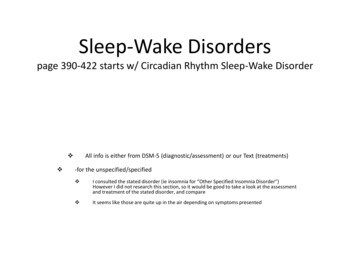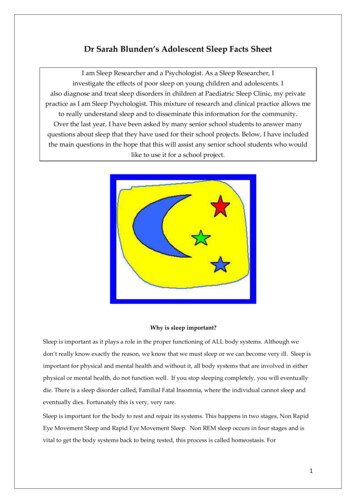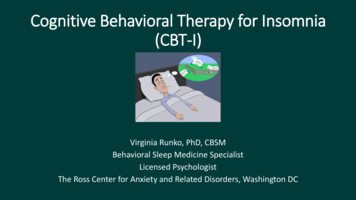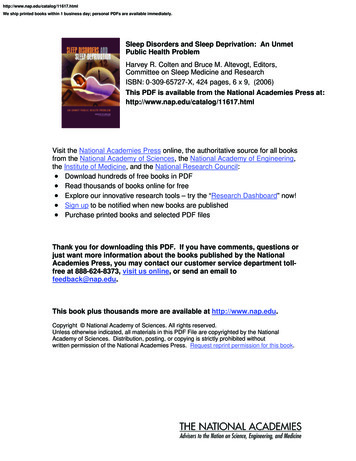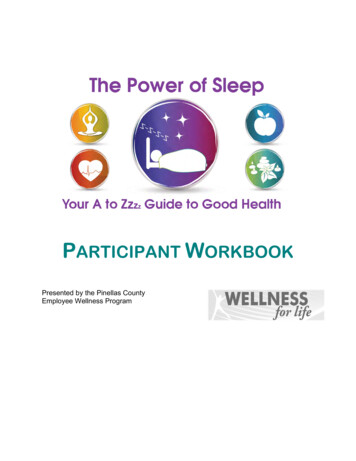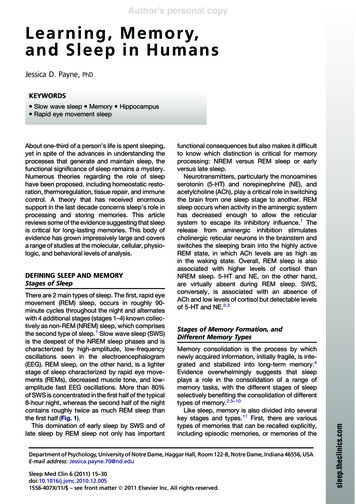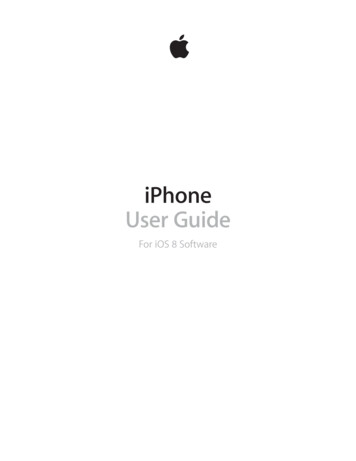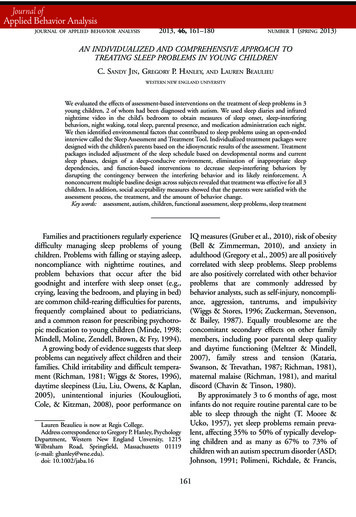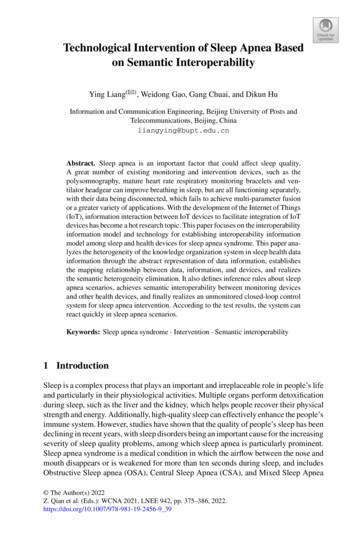
Transcription
Technological Intervention of Sleep Apnea Basedon Semantic InteroperabilityYing Liang(B) , Weidong Gao, Gang Chuai, and Dikun HuInformation and Communication Engineering, Beijing University of Posts andTelecommunications, Beijing, Chinaliangying@bupt.edu.cnAbstract. Sleep apnea is an important factor that could affect sleep quality.A great number of existing monitoring and intervention devices, such as thepolysomnography, mature heart rate respiratory monitoring bracelets and ventilator headgear can improve breathing in sleep, but are all functioning separately,with their data being disconnected, which fails to achieve multi-parameter fusionor a greater variety of applications. With the development of the Internet of Things(IoT), information interaction between IoT devices to facilitate integration of IoTdevices has become a hot research topic. This paper focuses on the interoperabilityinformation model and technology for establishing interoperability informationmodel among sleep and health devices for sleep apnea syndrome. This paper analyzes the heterogeneity of the knowledge organization system in sleep health datainformation through the abstract representation of data information, establishesthe mapping relationship between data, information, and devices, and realizesthe semantic heterogeneity elimination. It also defines inference rules about sleepapnea scenarios, achieves semantic interoperability between monitoring devicesand other health devices, and finally realizes an unmonitored closed-loop controlsystem for sleep apnea intervention. According to the test results, the system canreact quickly in sleep apnea scenarios.Keywords: Sleep apnea syndrome · Intervention · Semantic interoperability1 IntroductionSleep is a complex process that plays an important and irreplaceable role in people’s lifeand particularly in their physiological activities. Multiple organs perform detoxificationduring sleep, such as the liver and the kidney, which helps people recover their physicalstrength and energy. Additionally, high-quality sleep can effectively enhance the people’simmune system. However, studies have shown that the quality of people’s sleep has beendeclining in recent years, with sleep disorders being an important cause for the increasingseverity of sleep quality problems, among which sleep apnea is particularly prominent.Sleep apnea syndrome is a medical condition in which the airflow between the nose andmouth disappears or is weakened for more than ten seconds during sleep, and includesObstructive Sleep apnea (OSA), Central Sleep Apnea (CSA), and Mixed Sleep Apnea The Author(s) 2022Z. Qian et al. (Eds.): WCNA 2021, LNEE 942, pp. 375–386, 2022.https://doi.org/10.1007/978-981-19-2456-9 39
376Y. Liang et al.(MSA) [1] Patients suffering from sleep apnea snore during sleep and are likely toexperience a brief respiratory arrest during sleep, which leads to insufficient oxygensupply in the blood, reduced sleep quality, daytime drowsiness, memory loss, and insevere cases, psychological and intellectual abnormalities, and may even cause otherdiseases, such as arrhythmias, cerebrovascular accidents, and coronary heart disease. Toaddress these problems, research in scientific and timely monitoring of sleep apnea andthe possibility of providing timely intervention to patients is of extreme value [2].Polysomnography (PSG) is considered the “gold standard” for diagnosing apneaevents and some other sleep disorders. However, PSG devices are costly and requireelectrodes to be attached to the patient and tension sensors to be worn, which may leadto First Night Effect of the users and dislodgement of devices in the middle of the night.In addition, in the market, there are already mature heart rate respiratory monitoringbracelets or head-mounted respirators that can improve breathing problems during sleep,but because all these devices can interfere with human activity to varying degrees,thus having an impact on sleep quality on the other hand [3]. There is thus an urgentneed for a contactless, effective, and more accessible assistive device for monitor andintervention. A very important medical indicator to detect the occurrence of apnea eventsis called the arterial oxygen saturation (SaO2). Given that the accurate measurement ofSaO2 requires the facilitation from an oximeter, the interconnection of sleep monitoringdevices with an oximeter is a subject worth investigating. Additionally, existing sleephealth devices can detect the occurrence of disease but cannot timely conduct any reliefor rescue treatment. Therefore, if the monitoring equipment and rescue equipment canbe interconnected, the disease will be relived in a timely manner. For example, homecaredevices can alleviate certain reaction caused by acute symptoms and provides help for thesubsequent hospital treatment [4]. However, the health devices are currently developedseparately by different companies, which means that different conceptual expressionmodels and languages, and different degrees of formalization with the overlapping ofknowledge in different domains will lead to multiple inconsistencies and disconnection[5]. As a result, a multi-parameter fusion among the devices to provide richer applicationsbecome impossible. Interoperability can solve the problems of multiple device networkheterogeneity, data format conflicts, and incompatible interfaces, eventually realizingdata sharing and collaborative work among information systems. It is thus extremelyimportant to carry out study on the interoperability between heterogeneous devices [6].2 Related WorkAs of now, related departments and research institutions have presented various evaluation models to evaluate interoperability, among which Levels of Conceptual Interoperability Model (LCIM) is highly representative. It has six levels, namely no interoperability, technical interoperability, syntactic interoperability, semantic interoperability,pragmatic interoperability, and conceptual interoperability [7]. Semantic technologytargets integration and collaboration of heterogeneous systems by providing unifieddescriptions, and it is now very popular in recent years to study how to attach semantics to IoT systems. In 2006, Brock proposed the concept of SWOT (Semantic Web ofThings, SWOT), advocating that IoT should be called the Semantic Internet of Things.
Technological Intervention of Sleep Apnea377He believes that the internet, as a bridge between the physical world and the informationworld, should have an underlying sensing device of its own system that can provideinformation being aware of context and capable of reasoning, rather than focus on thechanges of the objects themselves. They should also be able to “communicate” and“understand” as human beings do, and to communicate collaboratively between devicesthrough registration, addressing, auto-discovery and search [8].Saman Iftikhar [9] studied the feasibility of semantic interoperability among various semantic languages and realizes interoperability between semantic informationexchange and resultant information systems across services. Shusaku Egami [10] investigates an ontology-based approach to semantic interoperability data integration for airtraffic management. A domain ontology that is based on the flight, aviation and weatherinformation exchange model is built, while an approach is proposed to integrate heterogeneous domain ontologies. As a result, interoperability of exchanging informationabout aircraft operations between different systems and operators in global air trafficmanagement is solved, while the interoperability and coordination of all kinds of information in global operations is enhanced. Soulakshmee Devi Nagowah [11] put forwardan approach based on new paradigms such as the Internet of Things and pedagogicalconcepts such as Learner Analysis, which is to build an ontology of IoT smart classrooms for university campuses to improve semantic interoperability in smart campusenvironments.Wanmei Li [12] from China University of Mining and Technology put forward asemantic interoperability system for mining equipment based on distributed query, usingsemantic technology to propose a somaticized description model for IoT in mines, anda task matching scheme based on compound reasoning, which enables mutual understanding and interaction between equipment and production systems. It has combinedsemantic technology, distributed system and edge computing framework and appliedthe integration in which is applied in mine production activities with an aim to reducehumanized mine production and improve automatic production efficiency of coal mines.In health, Bozhi Shi [13] studied the interoperability characteristics of heart monitorsand researched their data information exchange capability. To summarize, the existinginteroperability studies are in the process of development, and there is not a completestandard applicable to the health field in terms of the depth of related research. In addition,there are even fewer studies about the interoperability system of health equipment, sothe research of interoperability needs more attention (Fig. 1).3 Overview of Design ModelThis paper focuses on the interoperability information model and technology of devicesthat monitor and intervene with sleep apnea. Through analysis of the requirementsof interoperability of sleep apnea monitoring and intervention devices, an informationmodel is constructed to design a specific method to achieve the semantic interoperability.The specific research content is as follows:An ontology-based semantic description model of sleep monitoring devices is proposed from four aspects, namely the basic information, status, function, and operationcontrol, so that device information can be represented by a semantic document in aunified syntax format.
378Y. Liang et al.Fig. 1. Overall flow chart of model.In terms of the need of monitoring and intervention tasks, a semantic descriptionmodel of monitoring and intervention tasks is proposed to semantically describe thetask information. Meanwhile, a task matching scheme based on compound reasoningis proposed to strengthen the autonomy of the sleep device interoperability system.The study integrates the relevant theories and technologies of ontology, extracts theinformation of the device or task ontology, and then inputs it into the reasoning ontology,and guides the output device according to the designed reasoning rules.By interoperating the non-contact mattress and the oximeter, the heart rate and respiration rate calculated from the mattress and the initial judgment of whether an apneaevent has occurred are combined with the results of the real-time oxygen saturation fromthe oximeter, which are then input into the intervention task ontology and the inferencerule. If the apnea symptoms are serious, the oxygen production can be increased to helpthe human body keep the normal functioning; when the oxygen production is detectedto have reached a normal degree or no apnea event occurs for a long time, the oxygenproduction can be reduced or turned off. As a result, it provides a higher discriminantaccuracy than single mattress-based signal processing or single oximeter measurementresults, offering higher medical reference value.4 Implementation4.1 Creating an OntologyIn 1998, Tim Berners-Lee, the founder of the World Wide Web, first proposed the conceptof Sematic Web, and then the World Wide Web Consortium (W3C) developed a seriesof technological specifications related to the Semantic Web, including Web OntologyLanguage (OWL), Resource Description Framework (RDF). With the development ofthe Semantic Web, “ontology” has been introduced into computer science and given acompletely different meaning in recent years. An ontology is a systematic explanation ofthings in the objective world through a formal language, while the OWL provides a wayfor users to write formal descriptions of concepts [14]. OWL consists of three elements,
Technological Intervention of Sleep Apnea379Class: a collection of individuals with certain properties; Property: a binary relationshipbetween a class and another class; Individual: an instance of a class, which inherits theproperties of the class and facilitates the definition of data for reasoning. The OWL isused in this paper as the preferred language for ontology, while Protégé, an open-sourceontology editor designed by Stanford University is chosen to facilitate the research anddevelopment of ontologies.4.2 The Process of Creating an OntologyTo support autonomous and coordinated interactions among devices in an interoperablesystem, this section applies the powerful expressive power of semantic technologiesto modeling in health. From the aspect of practical application of apnea intervention,the devices, the discrimination and intervention tasks, and the execution progress of thetasks in the sleep environment are semantically described, which results in a sleep healthenvironment ontology system consisting of two domain ontologies, a sleep health deviceontology, and a task ontology. This study combines the seven-step approach of ontologycreation and METHONTOLOGY [15] as follows:Identification of the domain and scope of the ontology. The sleep health systemdescription ontology constructed in this study aims to provide the semantic support forintelligent collaboration between multiple devices in apnea discrimination and intervention tasks. The model mainly consists of two parts: device description model and taskdescription model.Reuse of existing ontologies. The ontology model related to sleep health system isextracted from the existing related ontologies, while the category attributes of relatedconcepts and their inter-concept binary relations are integrated. In the process of creatingontology, the scalability of the ontology model can be enhanced by the mapping betweenrelated concepts.Normalization of concepts. Firstly, class concepts are defined, and divided intoclasses of a hierarchy, i.e., important concepts are extracted from the corpus knowledge to form a glossary dedicated to the sleep environment, and a hierarchy is assignedto the concepts in the glossary. Secondly, the attributes of classes and their related constraints are defined according to the hierarchy. Finally, cases are built on the basis of theglossary to complete the creation of ontology.Validation and evaluation of ontology. The ontology editor is used to build the relevant glossaries and their related ontologies, while the ontologies are validated according to the indexes of practicality, cohesion, and accuracy, continuously improving theontology model.Device Description Model. SSN (Semantic Sensor Network Ontology, SSN) is anontology model issued by W3C. It is to describe sensors and provides a unified high-levelsemantic description of sensors in terms of deployment environment, functional role, andobserved properties. The modeling for sleep health discriminative interventions in thisstudy refers to the SSN ontology model and adds to it some control functions and otherconcepts. Based on the SSN ontology model and the analysis of the role of the devicein the sleep health IoT system, the device is described semantically in four aspects:
380Y. Liang et al.basic information, device function, status, and control, forming a unified representationmodel, and providing semantic level support for the sleep health interoperability system.The basic information refers to the description of some information that the devicehas since it was made by the manufacturer, such as the name, parameters, model andparts of the health device (oximeter, oxygen generator, mattress).The device status describes the real-time situation of devices. The main considerationin modeling the concept of device status is the relationship between the device andthe task, such as which operational state the oxygen generator is in and whether it isconditioned to perform the intervention task. In response to these questions, this paperprovides description in terms of operational state and perceived state.The device function refers to the specific tasks that the device can perform. Thisstudy describes the functions in control, measurement, input, and output of the threedevices, namely oximeter, mattress, and oxygen generator, and the discrimination andintervention tasks.The control describes the interaction between the devices and the control of thedevices. The control operation in this study refers to the control of the ventilator basedon the physiological parameters generated by the oximeter and the mattress. Therefore,the control operation is conducted through the on and off state of the oxygen generator(Fig. 2).Fig. 2. The entity-relationship diagram of device model.Equipment Model Evaluation. The quality of current ontology model can be evaluated in terms of its structure, operability, and maintainability, while its structure canbe further divided into cohesiveness, redundancy, and coupling [16] Cohesiveness isthe most frequently measured feature and can be quantified by the degree of independence of each module in the model and the correlation between internal concepts. Thehigher the cohesiveness, the better the cohesiveness of the system and the higher thedegree of closeness between concepts. The cohesiveness of an ontology model is mainlyinfluenced by the inheritance relationship between concepts within the ontology.In this study, M is used to simplify the conceptual model of the device ontology,so M1, M2, M3, and M4 represent the conceptual model of its basic information, the
Technological Intervention of Sleep Apnea381conceptual model of its state, the conceptual model of its function, and the conceptualmodel of its control, respectively. The cohesiveness of the conceptual model of the deviceontology is represented by C(M), which is calculated as: C(M)x 2 i n j ni 1j i r (ci ,cj )n(n 1)1n 1n 1(1)where n represents the number of nodes in the ontology model, r represents the relationship strength between two concepts in an ontology, c represents a class in the conceptmodel ontology. If the two classes are directly inherited or indirectly inherited, then requals to 1. If the number of concepts in the ontology model is 0, then the cohesivenessis 0. If there is only one concept in the model, the cohesiveness is 1 because the concept itself is the most compact structure in the model and does not depend on any otherconcept. mC(Mi )(2)AVG i 1mIn this study, the device ontology is divided into four conceptual models, and theaverage cohesion AVG formula of the device ontology is calculated, and the cohesionof each conceptual model can be calculated according to the above formula, C(M1) 0.82, C(M2) 0.71, C(M3) 0.63, and C(M4) 0.62, and the average cohesion of thefour models is obtained as 0.7, from which it can be considered that the concepts aremore closely related to the topic of sleep health devices.Task Description Model. This study creates a model of task first, and then describesthe discriminative and intervention task concepts in terms of basic information, conditional constraints, and inter-task relatedness. The semantic description of discriminativeintervention tasks and execution progress information enables the device to directlyunderstand the process of the current working task, so that it can determine whetherto participate in the execution of the task and the prerequisites needed for execution.Among them, the basic information is the most basic description of the task, includingtask name, ID, and attributes, with name and ID being used to identify the task, and taskattributes being used to describe the execution environment of the task. Task constraintsinclude state constraints and timing constraints, and only devices that satisfy these constraints are qualified to claim the task. Task correlation is a concept used to judge therelationship between tasks, including temporal sequence and dependency. The tasks thatcome later in the temporal sequence can only be executed after the previous task iscompleted. The mutual dependency is mainly reflected in the data dependency betweentwo tasks. For example, the execution of the intervention task requires the results of themonitoring task. The ontology and entity settings for the discrimination and interventiontasks in the sleep health system ontology are shown in the following figure (Fig. 3):
382Y. Liang et al.Fig. 3. The entity-relationship diagram of task model.4.3 ReasoningContradictory knowledge may appear in the process of model creating, which leadsto inconsistency of the ontology and affects the subsequent knowledge inference. Theconsistency of ontology is represented in three aspects: structural consistency, logicalconsistency, and user-defined consistency, referring to the ontology’s syntactic structure,syntactic logic, and a series of constraints specified by the user to comply with the constraints of the language syntax model respectively. To uphold the ontology consistency, itis important to ensure that classes, attributes, and case individuals that have been createdin the ontology are logically and structurally consistent. This step can further performthe rule reasoning. This study chooses HermiT and Pellet, two reasoners of Protégéto perform consistency testing of the ontology, imports the completed device ontologymodel and monitoring intervention task ontology into Protégé, and then performs thetesting in HermiT and Pellet. No error message is suggested in the testing results, whichproves that the term set and cases of the completed ontology system information areconsistent.The rules of reasoning need to be clarified before reasoning. Apnea is medicallydefined as the absence of or significant reduction of nasal or oral airflow for more than10 s during sleep, accompanied by a sustained respiratory effort and a decrease in oxygensaturation. As the mattress can collect human physiological signals to obtain real-timeheart rate and respiratory values, the signal processing can initially assess whether theuser has apnea or not. Even if the user doesn’t have apnea, it proves that the user’sheart rate and respiratory shift is slightly abnormal. Thus, semantic interconnectionwith the oxygen machine can automatically turn on the oxygen generator and releasea small amount of oxygen to avoid an acute anoxia. In addition, the oxygen saturationresults measured by the oximeter are also considered to determine whether an apneahas occurred, and if so, to increase the oxygen concentration. When the values of theuser’s heart rate, respiration and blood oxygen saturation recover to the normal range,it means that the physiological parameters are more normal during this time, and theincrease in oxygen in the air will lead to the opposite effect. Therefore, the oxygengenerator should automatically be adjusted to the non-operating state, finally forming aclosed-loop system (Fig. 4).
Technological Intervention of Sleep Apnea383Fig. 4. The overall reasoning process.5 Experiments5.1 Experiment SettingsThis study chooses local inputs instead of sensors, and preset values instead of mattress and oximeter operating performance and status. Considering only the predictionand discrimination of obstructive apnea syndrome, SWRL inference rules are set up inProtégé based on the above-mentioned reasoning. According to the reasoning of Pellet,20 rules of the rule base are applied. When the output of the mattress ontology showsthe occurrence of apnea, or when the decrease of blood oxygenation on the oximeterontology reaches or exceeds 3%, the oximeter ontology will increase the generation ofoxygen. When the value of the mattress ontology and oximeter ontology normalizes, theoximeter sill stop performing the task.5.2 PerformanceAssume the patient is in a bedroom of 15 m2 , where the oxygen generator is placedat about 3 m from the human body during sleep. The attendant will turn the oxygengenerator on when there are signs of apnea and turn it off when the respiratory and
384Y. Liang et al.heart rate recover to the normal level through the observation of the instruments. Inthe test, each instrument works separately, so the attendant must observe and judge thephysiological parameters before deciding on the status of the oxygen generator. Thewhole process can be divided into three steps: observation, judgment and action, andthe time spent in each step is different, with the most time spent in action, which greatlyincreases the length of time spent on the intervention. This study has conducted multiplesets of tests, assuming that the attendant can switch on the oxygen generator in the fastestspeed, then the average time consumed, minimum time consumed, and maximum timeconsumed were 1.883 s, 1.49 s and 2.26 s respectively. In Protégé, the average responsetime, minimum response time and maximum response time were 15.385 ms, 15.063 msand 15.612 ms respectively. The system performance would be better if the tasks wereperformed in binary (Fig. 5).Fig. 5. Comparison of 6 sets of data on the decision response time of the two operations.6 ConclusionSemantic interoperability is a very challenging research issue. This paper aims to addressthe collaborative interaction between sleep health devices to achieve semantic-level interoperability between monitoring devices and other health devices, ultimately building anunmonitored closed-loop system for sleep apnea intervention. The discrimination andintervention has been simply implemented in the platform of Protégé, and the ontologydesign and rule base need to be enriched specifically in the future research to supportmore complex scenarios. The testing of the system is also realized by simulation in anexperimental environment, which is inevitably too ideal, while real sleep environmentcan be highly unpredictable. Thus, further validation of the system in actual scenariosis needed in the future.Acknowledgements. This work is supported by National Key R&D Program of China undergrant number 2020YFC203303.
Technological Intervention of Sleep Apnea385References1. Gislason, T., Benediktsdóttir, B.: Snoring, apneic episodes, and nocturnal hypoxemia amongchildren 6 months to 6 years old. An epidemiologic study of lower limit of prevalence. Chest107(4), 963–966 (1995)2. Sharma, S.K., Kumpawat, S., Banga, A., Goel, A.: Prevalence and risk factors of obstructivesleep Apnea syndrome in a population of Delhi, India. Chest 130(1), 149–156 (2006)3. Peppard, P.E., Young, T., Palta, M., Skatrud, J.: Prospective study of the association betweensleep-disordered breathing and hypertension. N. Engl. J. Med. 342, 1378–1384 (2000)4. Magalang, U.J., Chen, N.H., Cistulli, P.A., et al.: Agreement in the scoring of respiratoryevents and sleep among international sleep centers. Sleep 36(4), 591–596 (2016)5. “W3C Semantic Web Activity”: World Wide Web Consortium (W3C), November 7, 2011,Retrieved 26 November 2011)6. Jambhulkar, S.V., Karale, S.J.: Semantic web application generation using Prote ge tool. In:2016 Online International Conference on Green Engineering and Technologies (IC-GET),Coimbatore, pp. 1–5 (2016)7. Canellas, M.C., Feigh, K.M., Chua, Z.K.: Accuracy and effort of decision-making strategieswith incomplete information: implications for decision support system design. IEEE Trans.Hum. Mach. Syst. 45(6), 686–701 (2015)8. Lakka, E., Nikolaos, E.: End-to-End Semantic Interoperability Mechanisms for IoT. Foundation for Research and Technology. Hellas (FORTH). IEEE (2019)9. Iftikhar, S.: Agent based semantic interoperability between agents and semantic web languages. In: 22nd International Conference on Advanced Information Networking andApplications. Workshops. IEEE (2008)10. Egami, S.: Ontology-based data integration for semantic interoperability in air traffic management. In: 2020 IEEE 14th International Conference on Semantic Computing (ICSC). IEEE(2020)11. Nagowah, S.D.: An ontology for an IoT-enabled smart classroom in a university campus.In: 2019 International Conference on Computational Intelligence and Knowledge Economy(ICCIKE). IEEE (2019)12. Li, W.: Research on Semantic Interoperability System of Mine Equipment Based onDistributed Query (2020)13. Shi, B.: Research on Interoperability Framework of Heart Ability Monitor for Personal HealthField (2017)14. Ornelas, T., Braga, R., David, J.M.N., et al.: Provenance data discovery through semanticweb resources. Concurr. Comput. Pract. Exper. 30(1), e4366 (2017)15. Corcho, Ó., Fernández-López, M., Gómez-Pérez, A., et al.: Building legal ontologies withMETHONTOLOGY and WebODE. In: International Seminar on Law & the Semantic Web:Legal Ontologies, Methodologies, Legal Information Retrieval, & Applications (2003)16. Gangemi, A., Catenacci, C., Ciaramita, M., et al.: Modelling ontology evaluation and validation. In: Semantic Web: Research & Applications, European Semantic Web Conference,Eswc, Budva, Montenegro, June 2016. Springer-Verlag (2006). https://doi.org/10.1007/11762256 13
386Y. Liang et al.Open Access This chapter is licensed under the terms of the Creative Commons Attribution 4.0International License (http://creativecommons.org/licenses/by/4.0/), which permits use, sharing,adaptation, distribution and reproduction in any medium or format, as long as you give appropriatecredit to the original author(s) and the source, provide a link to the Creative Commons license andindicate if changes were made.The images or other third party material in this chapter are included in the chapter’s CreativeCommons license, unless indicated otherwise in a credit line to the material. If material is notincluded in the chapter’s Creative Commons license and your intended use is not permitted bystatutory regulation or exceeds the permitted use, you will need to obtain permission directly fromthe copyright holder.
with their data being disconnected, which fails to achieve multi-parameter fusion . tigates an ontology-based approach to semantic interoperability data integration for air . C., Ciaramita, M., et al.: Modelling ontology evaluation and vali-dation. In: Semantic Web: Research & Applications, European Semantic Web Conference, Eswc, Budva .
